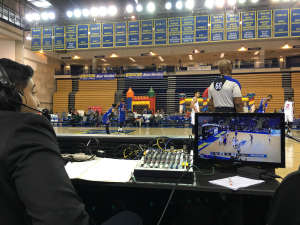NEWARK, Del. — On a dreary winter evening, everything glows yellow in the Bob Carpenter Center on the University of Delaware’s campus, the pregame hum of a growing crowd echoing around the squeaks of sneakers on the wooden floor. Camera operators set up shop like they might for any other basketball game: high overhead atop a retracted set of bleachers at center court and just off to the side of each basket stanchion along the baseline. But for fans of the hometown Delaware 87ers who haven’t braved the weather and treacherous road conditions to be here, the game won’t be broadcast on television. It will only be available on Facebook Live.
This remarkable development is not one the 87ers — the D-League affiliate for the Philadelphia 76ers — came to embrace on their own. It’s a league-wide initiative from the NBA, which moved its D-League broadcasts from YouTube to Facebook for this season. It’s also unclear exactly who prompted the switch in platform. Though the D-League may seem like a strange sandbox for Facebook to play in, it fits the trend of the company’s recent forays into the sports landscape.
Twitter inked its first broadcast deal last year, paying roughly $10 million for the opportunity to livestream 10 Thursday night broadcasts. That may seem like a bargain, but in addition to being some of the lowest-rated NFL games, the Thursday games were also not exclusively online, still available on television through traditional broadcast partners NBC, CBS and the NFL Network. That helps explain why the deal was far less costly than Yahoo’s $17 million investment to livestream a single, 9:30 a.m. ET game from London, for which it had no competition.
Just last June, Facebook made a point of saying it wasn’t planning to jump into the fray of acquiring sports broadcasting rights. Instead of making a major splash on the biggest stages of American sports, the tech giant has been quietly making deals around the edges, using teams and leagues with more flexibility as testing grounds.
The very first Facebook Live broadcast of a professional sporting event didn’t come from any particular league or even a team. Rather, without warning, the company sent a stream of the National Women’s Soccer League’s Orlando Pride’s franchise opener live via star player Alex Morgan’s personal page.
The broadcast reached an estimated 554,000 unique viewers, well better than the 76,000 it did over on YouTube, where it was also being broadcast. Those numbers hint at the expansive reach Facebook affords, thanks to its insanely large user base, which reached an estimated 1.86 billion active users in the fourth quarter of 2016.
But the Morgan experiment was just the first of several toe dips into the sports world, through which Facebook has been paying athletes and leagues to stream live games. Last fall, beIN Sports struck a deal to simulcast a few Conference USA college football games via Facebook Live. Meanwhile, Bleacher Report — a Turner Broadcasting-owned entity — used the service for several high school football games. They took their approach a step further, adding multiple novel camera feeds, trying innovations that traditional broadcasts avoid.
And the talks have been going both ways. Facebook approached the NWSL in a Chicago meeting with U.S. Soccer last year, according to a league spokesman. But for Facebook’s first foray into college basketball, the Atlantic 10 was the initiator.
“With the emerging trend of social media live video, I watched with interest the professional sport leagues’ partnerships with Facebook Live; thus we began exploring options that would allow us to take advantage of this technology trend,” A-10 commissioner Bernadette V. McGlade told WTOP in an email. “The early conversations with Facebook were extremely positive, and as you see productive, which led the A-10 to initiate this partnership.”
So the A-10 became the earliest adopter on the college level, becoming the first conference to sign a livestreaming deal with Facebook last year.
“The A-10 partnership with Facebook is in addition to our core television partners, leveraging the distribution for a higher number of conference men’s basketball games and perhaps additional events in the future,” said McGlade. “Utilizing social media in this way with a premier partner like Facebook Live in my opinion is crucial to staying relevant nationally and expanding our brand by engaging new demographics. The globalization for intercollegiate athletics through this partnership to distribute Division I men’s basketball has been significant.”
Especially in basketball, the point about globalization is crucial. George Washington has been a popular landing spot for international players for years, and the Colonials currently feature players from Quebec, Japan and Puerto Rico on their roster. According to a recent study of this year’s college basketball players, 11 percent were born outside the United States, a number that doubles at the NBA level. The Colonials will have their Facebook Live debut Feb. 26 when they host George Mason.
Facebook did not disclose the nature of its deals with the NWSL or the A-10. Rather than a headline-grabbing, multimillion dollar pact with the largest sports league in America, it has made inroads into the market in other ways and has made headlines in other sports by targeting individuals.
While Facebook’s public marketing continues to encourage the image of anyone and everyone spontaneously hopping on the platform to go “Live,” they are also working behind the scenes through official deals. Michael Phelps held a series of post-Olympic Q&A sessions on Facebook Live last year, creating a stir by using the platform to announce his retirement from swimming.
When Pittsburgh Steelers star receiver Antonio Brown unexpectedly streamed his coach’s jubilant, profane postgame locker room speech on Facebook Live, it was chalked up in the moment as an unwise, youthful indiscretion. It wasn’t until later that it was revealed Brown had signed a six-figure marketing deal with the company.
On Facebook’s end, the longer a user stays on the platform, the more advertising they’re exposed to. Few events capture a user’s constant attention for several hours like a sporting event. Facebook altered its Branded Content Policy last year, opening the path for verified Facebook Pages to share branded content, which creates revenue-driving opportunities. The company has also discovered that its video platform is a natural engagement driver, making it a particularly intriguing method of communication for organizations with passionate, captive audiences, like sports teams.
“Live videos generally give 10 times more comments than traditional (video on demand) on Facebook,” Dan Reed, head of sports partnerships, told The Drum last year.
Facebook did not make Reed available for comment about its current broadcast partnerships. But back at the A-10, McGlade said that single games have had a Facebook reach of over 1 million fans. Compare that to two recent weekend doubleheaders on NBCSN, for which three of the four games failed to even register a Nielsen rating. The only game that did — a UMass-Fordham matchup on Jan. 21 — averaged a .26 household rating, meaning just over 300,000 televisions were tuned in.
Reed, meanwhile, brings the story of Facebook’s sports petri dish full circle. He joined Facebook in July 2014 after spending 10 years working in the NBA front office. His final position before his move to Silicon Valley? President of the NBA D-League.
Despite multiple attempts, the NBA did not make anyone available to speak to specifics of the D-League’s deal. But back in Newark, 87ers director of marketing and communications Alex Yoh is thrilled with the early results and already looking for the next step in the technology’s usefulness.
“So much of our fan base is on Facebook. Young parents who have two kids — that’s our target audience. And they’re all on Facebook,” he said. “I think what’s next is, how do you monetize it? How do you turn that Facebook data into a reason to buy?”

Varun Raghupathi, 87ers broadcaster and a recent Syracuse grad, calls the 87ers games for radio and Facebook Live. He rues the service’s lack of a permanent video link (which YouTube provides) for his own professional purposes, but understands the ease for consumers.
“You can get a notification to your phone if you like a certain page. The fact that Facebook Live is two-three steps away, which is five-six seconds away, is very appealing,” he said. “Some social media skews younger, some skews older. But everybody has Facebook.”
The early numbers bear out the success. Raghupathi says a recent game drew over 13,000 viewers. His larger questions are ones of bandwidth as the service gains its footing. Can it reliably hold up on the level required to replace a traditional television broadcast?
“Facebook can get kind of glitchy at times; the video quality can lower because there’s more Facebook traffic,” Raghupathi said. “It’s not a perfect system.”
That statement turns out to be foreboding. For the first time this season, as they tip against the Rochester Knicks, there is a technical failure and the game doesn’t make it online. It’s part of the cost of business of any live broadcast, but especially so here in the wild west of livestreaming.
For a team with fewer than 10,000 Facebook followers, a reach of 13,000 for a game raises eyebrows. The Washington Nationals, for instance, have well over 650,000 followers. The Nats reportedly averaged about 68,000 viewers in prime time on MASN last year, a regional network that stretches across just a few states, rather than Facebook’s global reach. While MLB offers its own league-wide web streaming option, it’s not hard to imagine where the strength of the platform’s reach to a captive audience would be appealing for more major professional sports.
Facebook has been quiet about what’s coming next, whether or not it will make a more aggressive play into the big four American professional sports market. But as it continues to aggressively market its streaming service to the general public, it’s chipping away around the edges of the sports landscape, creating an interesting alternative to the traditional broadcast model.






